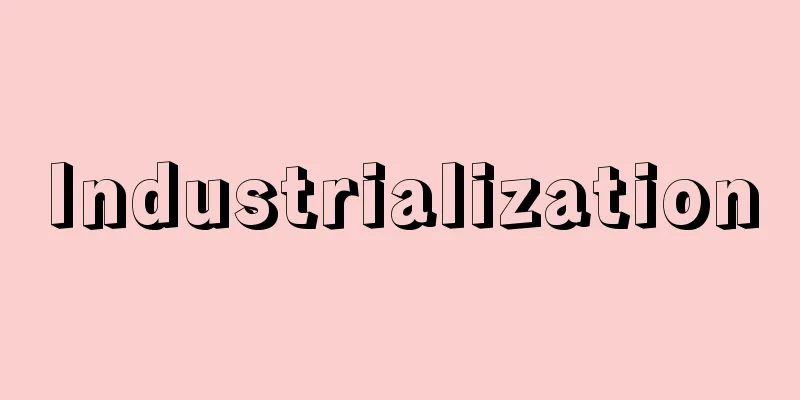Industrialization

|
It refers to the increase in the proportion of secondary industries, especially manufacturing, in a country's industrial structure, and is often understood as the process of economic growth in modern times. Modern economic growth was due to the remarkable development of productivity, mainly in the manufacturing industry, against the backdrop of technological innovation, and industrialization is considered to be a necessary condition for this. Economic growth can be seen as a sustained increase in per capita national income, which is generally accompanied by population growth and broad-based changes in the economic structure. The shift of labor from the primary industry to the secondary and tertiary industries due to rising national income levels was confirmed by C. G. Clark's empirical analysis, and S. S. Kuznets subsequently attempted a more comprehensive analysis of the changes in industrial structure during the process of modern economic growth, based on a vast amount of empirical data. These research results have revealed the following: (1) industrialization is premised on a sufficient increase in productivity in the agricultural sector (primary industry) so that there is a surplus sufficient to support people working in the industrial sector (secondary industry) after self-consumption, and that this surplus will continue to expand in scale; (2) the products of the agricultural sector consist mainly of necessities of life, and demand does not increase as rapidly as income increases, so the income elasticity of demand is small; (3) while in the agricultural sector, production costs per unit of product tend to increase as production volume increases, the opposite trend is seen in the industrial sector, and the degree of productivity increase due to technological innovation is also higher in the industrial sector. Therefore, in order to raise the national income level of a country, it is necessary to break away from being an agricultural nation into an industrial one, and while industrialization is the main goal of most developing countries, it is difficult for countries that are lagging behind in modernizing their agriculture to industrialize. In Great Britain, which was the first country in the world to achieve industrialization, the catalyst was the Industrial Revolution, which saw remarkable technological progress from the late 18th century to the early 19th century and the emergence of factory industry. Japan experienced this process from the end of the 19th century to the beginning of the 20th century (the 1880s and 1930s), and through the First World War, the focus of industrialization shifted from light industry to heavy chemical industry. A society in which industrialization has progressed is called an industrialized society, but the term "post-industrial society" was used and spread by American sociologist D. Bell and others from the mid-1960s to describe a society in which the proportion of tertiary industry has increased and the service-oriented economy has become even more advanced, as the next step after industrial society. In a post-industrial society in which the proportion of tertiary industry has increased and the service-oriented economy has become even more advanced, industries related to information, knowledge, and services play an important role instead of the production of goods. The term industrial society sometimes refers to both industrialized and post-industrial societies. [Masashi Miura] "An Analysis of Modern Economic Growth, by S.S. Kuznets, translated by Yuichi Shionoya, 2 volumes (1968, Toyo Keizai Shinposha)" ▽ "Introduction to Industrial Structure, by Goro Ono (Nikkei Bunko)" ▽ "Japan's Industrial Structure, by Takashi Suzuki (1995, Chuo Keizai)" [References] | | | | |Source: Shogakukan Encyclopedia Nipponica About Encyclopedia Nipponica Information | Legend |
|
一国の産業構造のなかで、第二次産業、とりわけ製造業の占める比重が高まることをいい、近代における経済成長の過程に置き換えられて理解される場合が多い。近代の経済成長は、技術革新を背景とする製造業を中心とした生産力の著しい発展によるものであり、工業化はその必須(ひっす)の条件であるとされている。 経済成長は、人口1人当りの国民所得の持続的上昇としてとらえることができるが、これは一般に、人口の増加と広範な経済構造の変化を伴う。国民所得水準の上昇による労働力の第一次産業から第二次、第三次産業への移動は、C・G・クラークの実証分析により確認されたが、その後、S・S・クズネッツは膨大な実証データに基づき、近代経済成長過程における産業構造変化の、より包括的な分析を試みている。こうした研究の結果、(1)工業化は、農業部門(第一次産業)において生産力が十分に上昇し、自己の消費後に工業部門(第二次産業)に従事する人々を養うに足るだけの余剰が存在し、その規模が増大していくことが前提となること、(2)農業部門の生産物は主として生活必需品から構成され、所得が増える割合ほどには需要の伸びがみられず、需要の所得弾力性が小さいこと、(3)農業部門では生産量の増大につれて生産物単位当りの生産費用が増加傾向を示すのに対し、工業部門ではこの逆の傾向がみられ、技術革新による生産性上昇の程度も工業部門のほうが高いこと、などが明らかにされている。 したがって、一国の国民所得水準を高めるには農業国から工業国への脱却が必要とされ、発展途上国のほとんどが工業化を主要な目標としているが、農業の近代化が遅れている国の工業化は困難である。工業化を世界に先駆けて実現したイギリスでは、18世紀後半から19世紀前半における目覚ましい技術進歩と工場制工業の出現による産業革命が契機となっている。わが国では、19世紀末から20世紀初頭(明治20~30年代)にかけてこの過程を経験し、続く第一次世界大戦を通じて、工業化の中心は軽工業から重化学工業へと移っていった。 工業化の進んだ社会は工業化社会とよばれているが、第三次産業の比重が増大し、経済のサービス化が一段と進んだ社会を、工業化社会の次にくるものとして、1960年代のなかばごろからアメリカの社会学者であるD・ベルらによって用いられ、広まったことばに脱工業化社会がある。第三次産業の比重が増大し、経済のサービス化が一段と進む脱工業化社会では、財の生産にかわって情報・知識・サービスなどに関する産業が重要な役割を果たす。 工業化社会と脱工業化社会を含めたものを産業社会とよぶ場合がある。 [三浦正史] 『S・S・クズネッツ著、塩野谷祐一訳『近代経済成長の分析』全2巻(1968・東洋経済新報社)』▽『小野五郎著『産業構造入門』(日経文庫)』▽『鈴木多加史著『日本の産業構造』(1995・中央経済社)』 [参照項目] | | | | |出典 小学館 日本大百科全書(ニッポニカ)日本大百科全書(ニッポニカ)について 情報 | 凡例 |
<<: Broad Church - Broad Church
>>: Business Opinion - Kougyouiken
Recommend
Old river mouth - Rōkaku
A county-level city in the northern part of Hubei...
Color Cream
…After World War II, the practice of dyeing dark ...
The origin of the transmission of Buddhism in the Three Kingdoms
A Buddhist book. 3 volumes. Completed in 1311 (Oc...
Hata Zouroku
1823-1890 A metal caster from the end of the Edo ...
Pacific League
Together with the Central League, this is one of t...
Tojun
A monk from the early Tang Dynasty in China. The ...
Soga no Emishi
A minister in the Asuka period. Son of Soga no Om...
Management accounting
Along with financial accounting, they constitute ...
Toby
American painter. Born in Wisconsin. Studied at th...
Schläfli, L. (English spelling) SchlafliL
…The term topology also first appeared in literat...
Bülow, O. (English spelling)
...In civil litigation, it is called a prerogativ...
frame
…A heated facility for raising seedlings made of ...
Octadecatongutstodiphosphate
...Ammonium salt (NH 4 ) 3 [PW 12 O 40 ]・4H 2 O, ...
Tsumiire (fish cake) - Tsumiire
Fish paste is rolled into balls and boiled. It is ...
Cryptozoic Era
…Some people consider the Precambrian period to b...




![Yame [city] - Stop](/upload/images/67cd0fe8a975b.webp)




